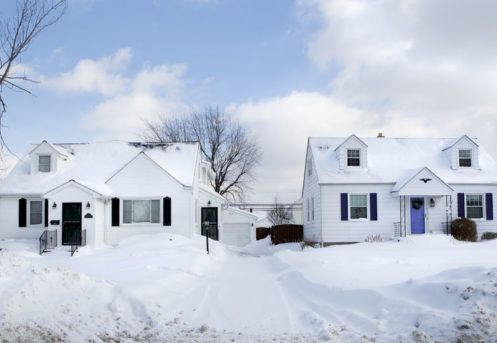Colorado is famous for its cold, snowy winters, and this makes having sufficient heating a must. Without a working furnace, your home would be unbearably cold, and your plumbing would quickly freeze. While most people in the Denver area have furnaces, many aren’t fully aware of how they work. Here is a full overview of how different types of furnaces work to provide heating to keep your home comfortable.
How Conventional Gas Furnaces Work
The majority of homes still use conventional gas furnaces. While not as energy efficient as newer condensing furnaces, conventional furnaces are still incredibly effective at keeping your home warm even when the temperature drops well below zero. These furnaces work by burning either natural gas or propane to create heat.
When heat is required, the furnace first opens up its gas valve. Gas flows into the combustion chamber and mixes with air. The burner then ignites the gas to produce heat energy. Inside the combustion chamber is a heat exchanger. As the gas burns, it instantly raises the temperature of the heat exchanger.
To provide heating, the HVAC blower fan draws cold air into the return ductwork and then forces this air through the heat exchanger. This raises the temperature of the air, and the heated air is then circulated throughout the supply ducts and into each room.
As the gas burns, it produces harmful combustion gases like carbon monoxide. These gases are drawn up into the flue and then vented outside of the house.
Older furnaces typically use a standing pilot light for ignition. This type of pilot has a constant flame that instantly ignites the gas whenever it flows into the chamber. The issue with a standing pilot is that it constantly uses a small amount of gas, and this reduces the furnace’s efficiency.
To avoid this energy waste, most newer furnaces typically use some type of electric ignition system instead of a standing pilot light. Some units use an intermittent pilot. This works similarly to a standing pilot except that the furnace automatically creates a flame when it turns on and then puts the flame out when it shuts off.
Other units use a spark to ignite the gas instead of a flame similar to how you might light your barbecue grill. There are also some furnaces that have a hot-surface igniter, which uses electricity to instantly heat up a small metal probe until it is red and glowing. This quickly produces enough heat that the gas instantly ignites as it flows over the hot probe.
Understanding High-Efficiency Condensing Furnaces
The issue with conventional furnaces is that they can only absorb so much heat energy from the burning gas. Furnace efficiency is measured by the percentage of the heat energy that they can capture. This is referred to as Annual Fuel Utilization Efficiency or AFUE. Most of these furnaces can only capture around 80 to 90% of the energy created when the gas burns, which means they have an AFUE of between 80 and 90. All new furnaces are required by law to have an AFUE of at least 80.
The reason that conventional furnaces aren’t all that efficient is that the combustion gases still retain a lot of latent heat when they exit out through the flue, and this results in that heat energy being wasted. High-efficiency condensing furnaces work in a slightly different way and have a much higher AFUE. Most of these units are at least 94 AFUE, and some have an AFUE as high as 98.5.
Instead of venting out the hot gases as in a conventional furnace, a condensing furnace utilizes a secondary heat exchanger since the primary heat exchanger can only absorb so much energy. After the combustion gases heat up the primary exchanger, they then travel into the secondary heat exchanger. This additional heat exchanger absorbs the majority of the remaining heat from the combustion gases before they flow out through the exhaust vent.
The only issue with this process is that the gases will cool off enough that condensation forms. This is why all high-efficiency furnaces need to have a condensate drain line just like your air conditioner does. As the gases cool inside the secondary heat exchanger, moisture in the air condenses into water. The water drips down into a drain pan and then flows out through the condensate pipe into a nearby floor drain.
An Introduction to Modulating Furnaces
There is also another type of high-efficiency furnace known as a modulating furnace. This works exactly like any other condensing furnace in that it uses two heat exchangers. The difference is that a modulating furnace utilizes a variable-speed blower fan and a modulating gas valve. Most furnaces can only run at high speed, and this often causes the temperature to fluctuate quite a lot between when the furnace is on and off.
Instead of always having to run at full speed, a modulating furnace has electronic controls that can automatically adjust the speed at which the fan runs and how much gas the unit burns at any one time. This creates major energy savings as it reduces the amount of gas and electricity that the heating system consumes. Once the home is heated to the desired temperature, the furnace slows down to run on the lowest speed and only produces a small amount of heat. This ensures it maintains a more consistent temperature and can help to eliminate problems with cold and hot spots in different parts of the home.
How Electric Furnaces Provide Heating
Electric furnaces work similarly to gas furnaces. The only difference is the way the heat exchanger is warmed. With an electric furnace, electricity flows into a resistance coil inside the heat exchanger. This current causes the coil to almost instantly become red hot and warms the heat exchanger. As the blower fan draws cool air into the furnace, the heat energy is transferred from the heat exchanger to the air.
Electric furnaces are even more efficient than even the best condensing furnace. Any modern electric furnace will have an AFUE of 100, which means there is zero energy wasted. Electric furnaces also don’t produce any fumes, which means they don’t require an exhaust vent. The only reason that electric furnaces aren’t as popular is due to their higher energy costs despite being more efficient. This is simply because electricity rates are usually higher than natural gas.
Denver’s Home Heating Experts
If you have any questions about your home’s furnace, the friendly, knowledgeable team at Summit Heating, A/C, Plumbing & Electrical is happy to help. We have been serving the Denver Metro area for more than two decades, and our team has more than 80 years of professional HVAC experience. All of our technicians are NATE-certified and work on all makes, models and types of furnaces. We specialize in heating repairs, maintenance and new furnace installations, and we also work on air conditioners, mini-splits and heat pumps. If you need a new HVAC unit, we offer free estimates on all new installations. Financing for new equipment is available on approved credit. We also back up all of our work with a 100% satisfaction guarantee. For more information or to schedule a service call, contact Summit Heating, A/C, Plumbing & Electrical today.


